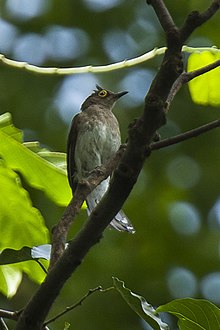| Yellow-wattled bulbul | |
|---|---|

| |
| Conservation status | |
 Least Concern (IUCN 3.1) | |
| Scientific classification | |
| Domain: | Eukaryota |
| Kingdom: | Animalia |
| Phylum: | Chordata |
| Class: | Aves |
| Order: | Passeriformes |
| Family: | Pycnonotidae |
| Genus: | Poliolophus Sharpe, 1877 |
| Species: | P. urostictus |
| Binomial name | |
| Poliolophus urostictus (Salvadori, 1870) | |

| |
| Synonyms | |
| |
The yellow-wattled bulbul (Poliolophus urostictus) is a species of songbird in the bulbul family of passerine birds. It is endemic to the Philippines. Its natural habitat is tropical moist lowland forests and forest edge
Description and taxonomy
EBird describes the bird as "A medium-sized bird of lowland and foothill forest. Dark brown above with a grayish brown head with a slight crest, a warmer brown chest and sides, a white center of the belly, white under the base of the tail, and white tips to the undertail. Note the prominent yellow eye-ring. Somewhat similar to Zamboanga and Philippine Bulbuls, but Yellow-wattled has a crest and an obvious yellow eye-ring. Song consists of a short, rather tuneless whistled melody, often finishing higher." The yellow-wattled bulbul was described by Tommaso Salvadori in 1870. In common with the blue-wattled bulbul, it is alternately referred to as simply the wattled bulbul.
Subspecies
Five subspecies are recognized:
- P. u. ilokensis - Rand & Rabor, 1967: Found on northern Luzon
- P. u. urostictus - (Salvadori, 1870): Found on central and southern Luzon, Catanduanes and Polillo Island
- P. u. atricaudatus - Parkes, 1967: Found on Samar, Biliran, Leyte, Bohol Negros and Panaon Island
- P. u. philippensis - (Hachisuka, 1934): Found on Dinagat, Siargao, Bucas Grande and Mindanao (except the Zamboanga Peninsula)
- P. u. basilanicus - (Steere, 1890): Originally described as a separate species. Found on the Zamboanga Peninsula (western Mindanao) and Basilan
Habitat and conservation status
Its natural habitats at tropical moist lowland secondary forest and forest edge up to 1,000 meters above sea level, it tends to avoid more intact primary forest
The IUCN Red List has assessed this bird as least-concern species as it has a wide range and seems to be able to persist and even thrive in degraded habitats.
References
- ^ BirdLife International (2016). "Poliolophus urostictus". IUCN Red List of Threatened Species. 2016: e.T22712710A94344535. doi:10.2305/IUCN.UK.2016-3.RLTS.T22712710A94344535.en. Retrieved 14 November 2021.
- ^ Gill, F.; Donsker, D.; Rasmussen, P. (eds.). "Family Pycnonotidae". IOC World Bird List. Version 10.2. International Ornithological Congress. Retrieved 3 August 2020.
- "Yellow-wattled Bulbul - eBird". ebird.org. Retrieved 2024-09-08.
- Fishpool, Lincoln; Tobias, Joseph A. (2023). "Yellow-wattled Bulbul (Microtarsus urostictus), version 1.1". Birds of the World. doi:10.2173/bow.yewbul1.01.1. ISSN 2771-3105.
- IUCN (2016-10-01). Poliolophus urostictus: BirdLife International: The IUCN Red List of Threatened Species 2016: e.T22712710A94344535 (Report). International Union for Conservation of Nature. doi:10.2305/iucn.uk.2016-3.rlts.t22712710a94344535.en.
| Taxon identifiers | |
|---|---|
| Pycnonotus urostictus | |
| Pycnonotus urostictus | |
This Pycnonotidae-related article is a stub. You can help Misplaced Pages by expanding it. |